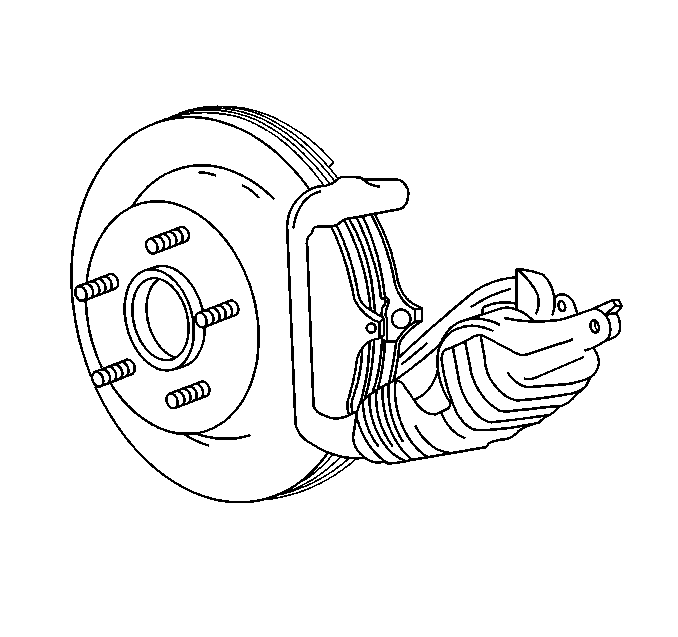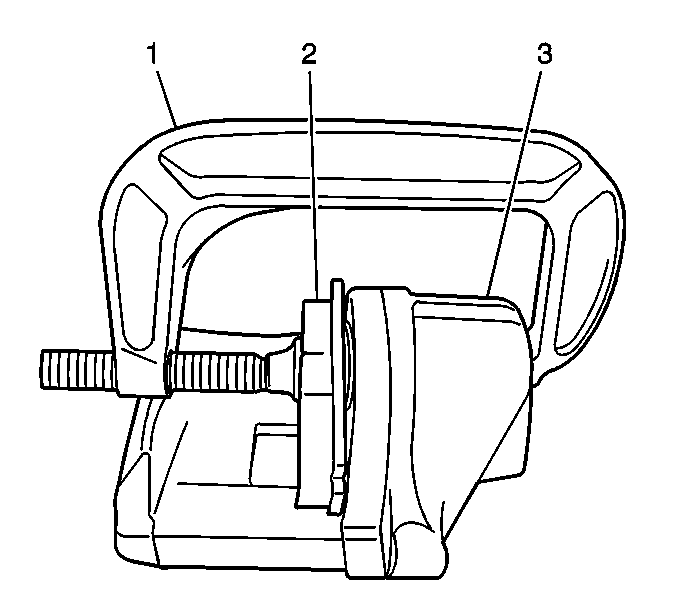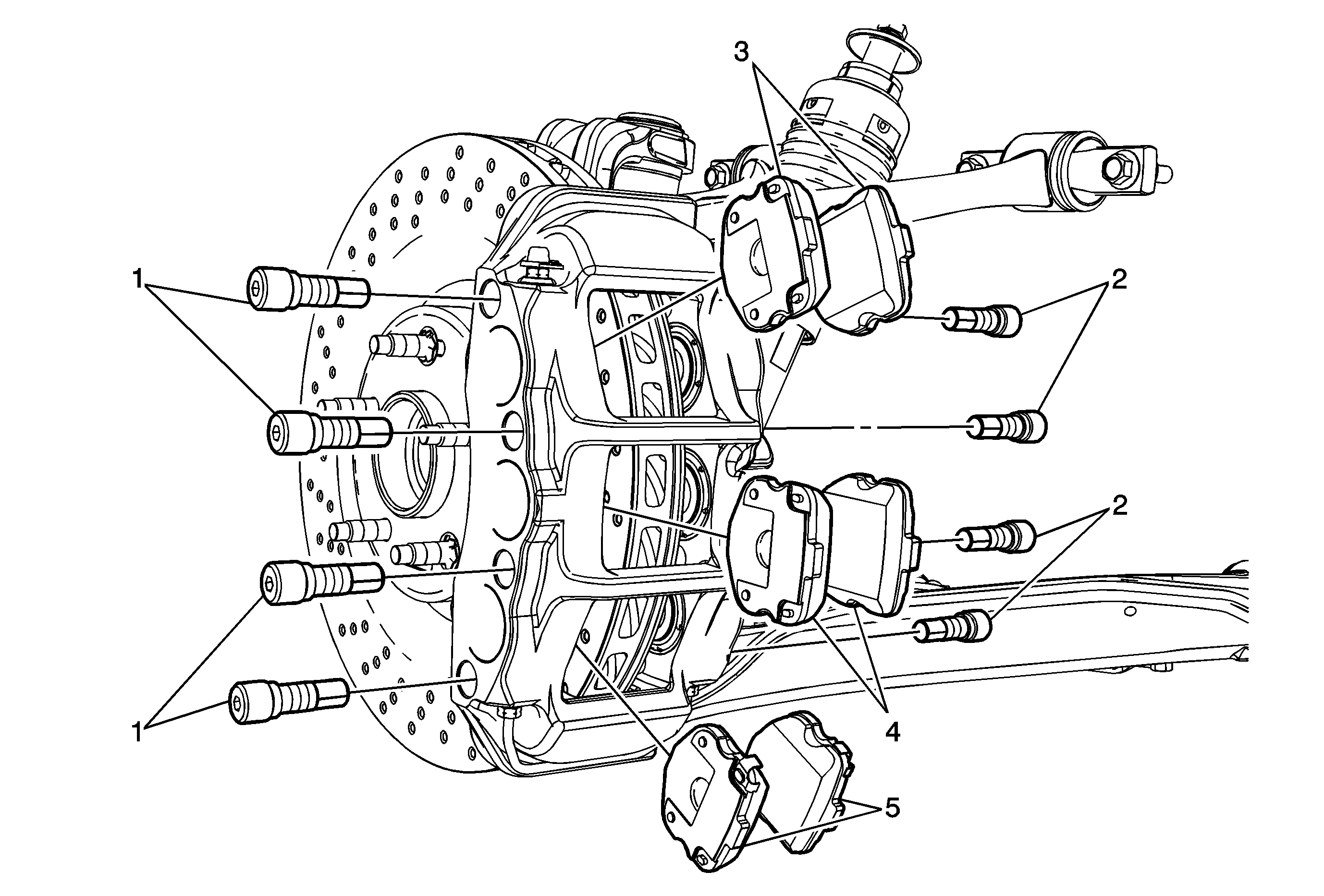Front Disc Brake Pads Replacement JL9-J55
Removal Procedure
Caution: Refer to Brake Dust Caution in the Preface section.
- Inspect the fluid level in the brake master cylinder reservoir.
- If the brake fluid level is midway between the maximum-full point and the minimum allowable level, no brake fluid needs to be removed from the reservoir before proceeding.
- If the brake fluid level is higher than midway between the maximum-full point and the minimum allowable level, remove brake fluid to the midway point before proceeding.
- Raise and suitably support the vehicle. Refer to Lifting and Jacking the Vehicle.
- Remove the tire and wheel assembly. Refer to Tire and Wheel Removal and Installation.
- Hand tighten a wheel lug nut to a wheel stud to secure the rotor to the hub.
- Install a large C-clamp over the body of the brake caliper with the C-clamp ends against the rear of the caliper body and against the outboard brake pad.
- Tighten the C-clamp evenly until the caliper pistons are compressed into the caliper bores enough to allow the caliper to slide past the brake rotor.
- Remove the C-clamp from the caliper.
- Remove the upper brake caliper guide pin bolt.
- Pivot the brake caliper body downward and secure the caliper out of the way with heavy mechanic's wire or equivalent. Ensure that there is no tension on the hydraulic brake flexible hose. Do NOT disconnect the hydraulic brake flexible hose from the caliper.
- Remove the brake pads from the caliper bracket.
- Remove and inspect the brake pad retainers from the caliper bracket.


Notice: Support the brake caliper with heavy mechanic wire, or equivalent, whenever it is separated from its mount and the hydraulic flexible brake hose is still connected. Failure to support the caliper in this manner will cause the flexible brake hose to bear the weight of the caliper, which may cause damage to the brake hose and in turn may cause a brake fluid leak.
Installation Procedure
- Inspect the caliper slide boots for cuts, tears, or deterioration. If damaged, replace the slides and the boots. Refer to Front Disc Brake Hardware Replacement.
- Install a large C-clamp (1) over the body of the brake caliper (3) with the C-clamp ends against the rear of the caliper body and against an old inboard brake pad (2) or a wood block installed against the caliper pistons.
- Tighten the C-clamp (1) evenly until the caliper pistons are compressed completely into the caliper bores.
- Remove the C-clamp and the old brake pad or wood block from the caliper.
- Install the brake pad retainers to the caliper bracket.
- Install the brake pads to the caliper bracket. The brake pad wear sensor, mounted on the inboard brake pad, must be positioned so that it is in the leading bottom position during forward rotation of the brake rotor.
- Pivot the brake caliper upward, over the brake pads and into the caliper bracket.
- Install the upper brake caliper guide pin bolt.
- Install the tire and wheel assembly. Refer to Tire and Wheel Removal and Installation.
- Lower the vehicle.
- With the engine OFF, gradually apply the brake pedal to approximately 2/3 of its travel distance.
- Slowly release the brake pedal.
- Wait 15 seconds, then repeat steps 11-12 until a firm brake pedal apply is obtained. This will properly seat the brake caliper pistons and brake pads.
- Fill the brake master cylinder reservoir to the proper level. Refer to Master Cylinder Reservoir Filling.
- Burnish the pads and rotors. Refer to Brake Pad and Rotor Burnishing.


Notice: Refer to Fastener Notice in the Preface section.
Tighten
Tighten the brake caliper guide pin bolt to 31 N·m (23 lb ft).
Front Disc Brake Pads Replacement J56

Callout | Component Name |
|---|---|
|
Caution: Refer to Brake Dust Caution in the Preface section. Preliminary Procedures
| |
1 | Disc Brake Pad Pin, Outboard (Qty: 4) Notice: Refer to Fastener Notice in the Preface section. ProcedureHand install the disc brake pad pins while gently rocking the disc brake pads. The pins should require little effort to install. Tighten |
2 | Disc Brake Pad Pin, Inboard (Qty: 4) ProcedureHand install the disc brake pad pins while gently rocking the disc brake pads. The pins should require little effort to install. Tighten |
3 | Disc Brake Pads, Trailing (Qty: 2) ProcedureUsing a brake pad spreader tool, compress the brake caliper pistons into the caliper bores. |
4 | Disc Brake Pads, Center (Qty: 2) ProcedureUsing a brake pad spreader tool, compress the brake caliper pistons into the caliper bores. |
5 | Disc Brake Pads, Leading (Qty: 2) Procedure
|
